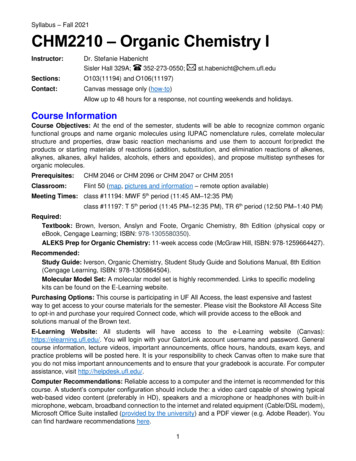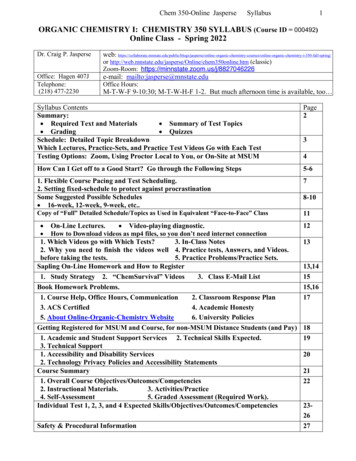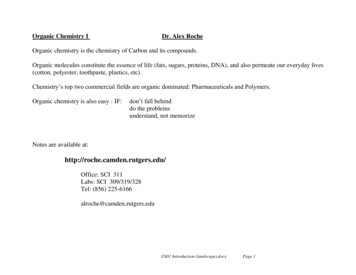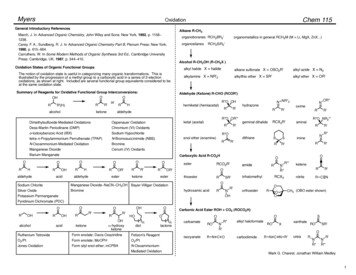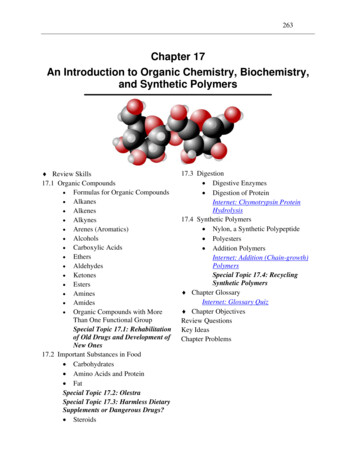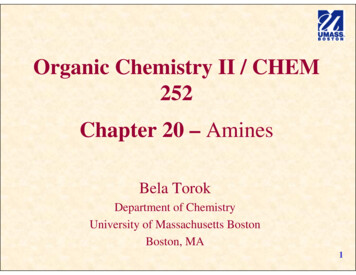
Transcription
Organic Chemistry II / CHEM252Chapter 20 – AminesBela TorokDepartment of ChemistryUniversity of Massachusetts BostonBoston, MA1
Nomenclature Nomenclature Primary amines are named in systematic (IUPAC) nomenclature byreplacing the -e of the corresponding parent alkane with -amine In common nomenclature they are named as alkylamines Simple secondary and tertiary amines are named in common nomenclatureby designating the organic groups separately in front of the word amine In systematic nomenclature, the smaller groups on the amine nitrogen aredesignated as substituents and given the locant N2
Nomenclature In IUPAC nomenclature the substitutent -NH2 is called the amino group– Aryl Amines The common arylamines have the following names:3
Nomenclature– Heterocyclic Amines The important heterocylcic amines have common names In IUPAC nomenclature the prefixes aza-, diaza- and triazaare used to indicate that nitrogen has replaced carbon in thecorresponding hydrocarbon– The nitrogen is assigned position 1 and the ring isnumbered to give the lowest overall set of locants to theheteroatoms4
Nomenclature5
Physical PropertiesPhysical Properties and Structure of Amines Primary and secondary amines can form hydrogen bonds toeach other and water Tertiary amines cannot form hydrogen bonds to each other butcan form hydrogen bonds to hydrogen bond donors such aswater Tertiary amines have lower boiling points than primary orsecondary amines of comparable molecular weights Low molecular weight amines tend to be water soluble whetherthey are primary, secondary or tertiary6
Physical Properties7
Structure Structure of Amines The nitrogen atom in an amine is sp3 hybridized - tetrahedral geometry– only the groups - trigonal pyramidal It is usually impossible to resolve amine enantiomers that are chiral atnitrogen because they interconvert rapidly– The interconversion occurs through a pyramidal or nitrogeninversion involving the unshared electron pair8
Structure Quaternary ammonium salts can be resolved into enantiomers– Chiral quaternary ammonium salts cannot undergonitrogen inversion because they lack an unshared electronpair on the nitrogen atom9
Basicity Amines are weak bases Relative basicity of amines can be compared in terms of pKa values fortheir respective conjugate acids– The more basic the amine, the higher the pKa of its conjugate acidwill be Primary alkyl amines are more basic than ammonia– An alkyl group helps to stabilize the alkylaminium ion10
Basicity gas phase : basicity increases with increasing methyl substitution aqueous solution: trimethylamine is less basic than dimethyl- ormethylamine– An alkylaminium ion in water is solvated and stabilized by hydrogenbonding of its hydrogens with water– The trimethylaminium ion has only one hydrogen with which tohydrogen bond to water– The trimethylaminium ion is solvated less well (and thereforestabilized less) than the dimethylaminium ion, which has twohydrogen atoms for hydrogen bonding11
Basicity Arylamines are weaker bases than nonaromatic cyclohexylamines The unshared electron pair is delocalized to the ring– The lone pair is less available for protonation, i.e., it is less basic Protonation of aniline is also disfavored because a protonated arylaminehas only two resonance forms– Anilinium ion is not as well stabilized by resonance as aniline itself12
Basicity– Basicity of Heterocyclic Amines Nonaromatic heterocyclic amines have approximately the same basicityas their acyclic counterparts Aromatic heterocyclic amines (in aqueous solution) are much weakerbases than nonaromatic amines13
Basicity– Amines versus Amides Amides are much less basic than amines– The pKa of a protonated amide is typically about zero One reason for this much lower basicity is that the amide is greatlystabilized by resonance but the protonated amide is not A more important reason for the weaker basicity of amides is that thenitrogen lone pair is delocalized, amides are protonated at the oxygen– Protonation at the oxygen allows resonance stabilization of thepositive charge14
Salts– Aminium Salts and Quaternary Ammonium Salts Protonation of amines with acids leads to formation of aminium salts– Aminium salts are formed from 1o, 2o or 3o amines and the aminiumion bears at least one hydrogen Quaternary ammonium salts have four groups on the nitrogen– The nitrogen atom is positively charged but does not bear ahydrogen atom15
Salts Quaternary ammonium halides are not basic because they do not have anunshared electron pair on nitrogen Quaternary ammonium hydroxides are very basic because they containthe very strong base hydroxide16
Basicity– Solubility of Amines in Aqueous Acid Many aminium chlorides, bromides, iodides and sulfates are watersoluble Solubility of amines in dilute acid can be used as a chemical test Amides are not basic and are not soluble in aqueous acids17
Resolving Agents– Amines as Resolving Agents A chiral amine can be used to resolve a racemic mixture of carboxylicacids by formation of diastereomeric salts18
Synthesis of AminesBy Nucleophilic Substitution Reactions Alkylation of Ammonia– Reaction of ammonia with an alkyl halide– Using an excess of ammonia helps to minimize multiplealkylations19
Synthesis of Amines Alkylation of Azide Ion followed by Reduction The Gabriel Synthesis for primary amines20
Synthesis of Amines– Preparation of Aromatic Amines by Reduction of Nitro Compounds Aromatic amines can be synthesized by reduction of the correspondingnitro compound One molar equivalent of hydrogen sulfide in alcoholic ammonia can beused to reduce one nitro group in the presence of another21
Synthesis of Amines– Preparation of Primary, Secondary and Tertiary Amines throughReductive Amination22
Synthesis of Amines The reduction can be accomplished using catalytic hydrogenation or ahydride reducing reagent– NaBH3CN and LiBH3CN are especially effective in reductiveaminations23
Synthesis of Amines– Preparation of Primary, Secondary, or Tertiary Amines through Reductionof Nitriles, Oximes, and Amides24
Synthesis of Amines Reduction can be accomplished by using catalytic hydrogenation orLiAlH4 Monoalkylation of an amine can be achieved by acylation of the amineand then reduction of the resulting amide25
Synthesis of Amines– Preparation of Primary Amines by the Hofmann and CurtiusRearrangements An unsubstituted amide can be converted to a primary amine by formalloss of the amide carbonyl through the Hofmann rearrangement (alsocalled the Hofmann degradation) The first two steps of the mechanism result in N-bromination of theamide– The N-bromoamide is deprotonated and rearranges to an isocyanate– The isocyanate is hydrolyzed to a carbamate which decarboxylatesto the amine26
Synthesis of Amines27
Synthesis of Amines The Curtius rearrangement occurs through the intermediacy of anacyl azide– The acyl azide is obtained from an acid chloride– Rearrangement of the acyl azide occurs with loss of N2, a verystable leaving group– In the last step, the isocyanate is hydrolyzed by adding water28
Reactions of AminesThe lone pair of the nitrogen atom accounts for most chemistry of amines– The unshared electron pair can act as a base or as a nucleophile The nitrogen lone pair can also make a carbon nucleophilic byresonance29
Reactions of AminesOxidation of Amines Primary and secondary amines undergo N-oxidation, but usefulproducts are not obtained because of side-reactions Tertiary amines undergo clean N-oxidation30
Reactions of Amines Reactions of Amines with Nitrous Acid Nitrous acid (HONO) is prepared in situ by reaction of sodium nitritewith a strong aqueous acid Primary amines undergo diazotization with nitrous acid– The unstable diazonium salts decompose to form carbocations31
Reactions of AminesReaction of primary arylamines with nitrous acid results in the formation ofrelatively stable arenediazonium salts– This reaction occurs through the intermediacy of an N-nitrosoamine– The N-nitrosoamine is converted to a diazonium ion32
Reactions of Amines Replacement Reactions of Arenediazonium Salts - Sandmeyer Reactions Aryldiazonium salts react readily with various nucleophilic reagents togive a wide variety of aromatic compounds33
Reactions of Amines– Practical Application of replacement with H Example: m-Bromotoluene cannot be made directly fromeither toluene or bromobenzene– N-acetylation is used to reduce the activating effect of theamine34
Reactions of Amines Coupling Reactions of Arenediazonium Salts Arenediazonium ions react as electrophiles with highly reactivearomatic compounds such as phenol and aromatic tertiary amines– The reaction is called a diazo coupling reaction Coupling with phenol occurs best in slightly alkaline solution– The alkaline solution produces a phenoxide ion that couples morerapidly, if the solution is too alkaline, a nonreactive diazohydroxideis produced35
Reactions of Amines Phenol and aniline derivatives undergo coupling almost exclusively at thepara position unless this position is blocked Azo compounds are commonly used as dyes– The azo coupling results in compounds which are highly conjugated– The -SO3-Na group is added to the molecule for solubility and tolink the dye to the polar fibers of wool, cotton etc.– Orange II is made from 2-naphthol36
Reactions of AminesSafraninCrystal violet193537
Reactions of Amines Reactions of Amines with Sulfonyl Chlorides Primary and secondary amines react with sulfonyl chlorides toproduce sulfonamides– A sulfonamide can be hydrolyzed to an amine by heatingwith aqueous acid38
Reactions of Amines– The Hinsberg Test This test can distinguish between 1o, 2o and 3o amines An amine and benzenesulfonyl chloride are mixed with aqueouspotassium hydroxide; the reaction is acidified in a second step– The results are different depending on the class of amine A benzenesulfonamide from a primary amine is soluble in basicsolution, but precipitates upon acidification39
Reactions of Amines A secondary amine forms a precipitate directly because an N,Ndisubstituted sulfonamide remains insoluble in basic solution There is no acidic hydrogen in an N,N-disubstituted sulfonamide A tertiary amine will not react to form a sulfonamide, but will dissolveupon acidification– Acidification converts the amine to a water soluble iminium salt40
Reactions of Amines Eliminations Involving Ammonium Compounds– The Hofmann Elimination An E2-type reaction occurs when a quaternary ammonium hydroxide isheated– An amine is a relatively good leaving group A quaternary ammonium hydroxide can be made from a quaternaryammonium halide using silver oxide41
Reactions of Amines Hofmann elimination and other elimination reactions of chargedsubstrates proceed to give the least substituted double bond– This is called the Hofmann rule, and the least substituted alkeneproduct is called the Hofmann product42
Reactions of Amines– The Cope Elimination A tertiary amine oxide will undergo elimination when heated Tertiary amine oxides can be made from tertiary amines by reactionwith hydrogen peroxide– the elimination is syn and proceeds via a cyclic transition state43
Organic Chemistry II / CHEM 252 . The lone pair of the nitrogen atom accounts for most chemistry of amines – The unshared electron pair can act as a base or as a nucleophile The nitrogen lone pair can also make a



